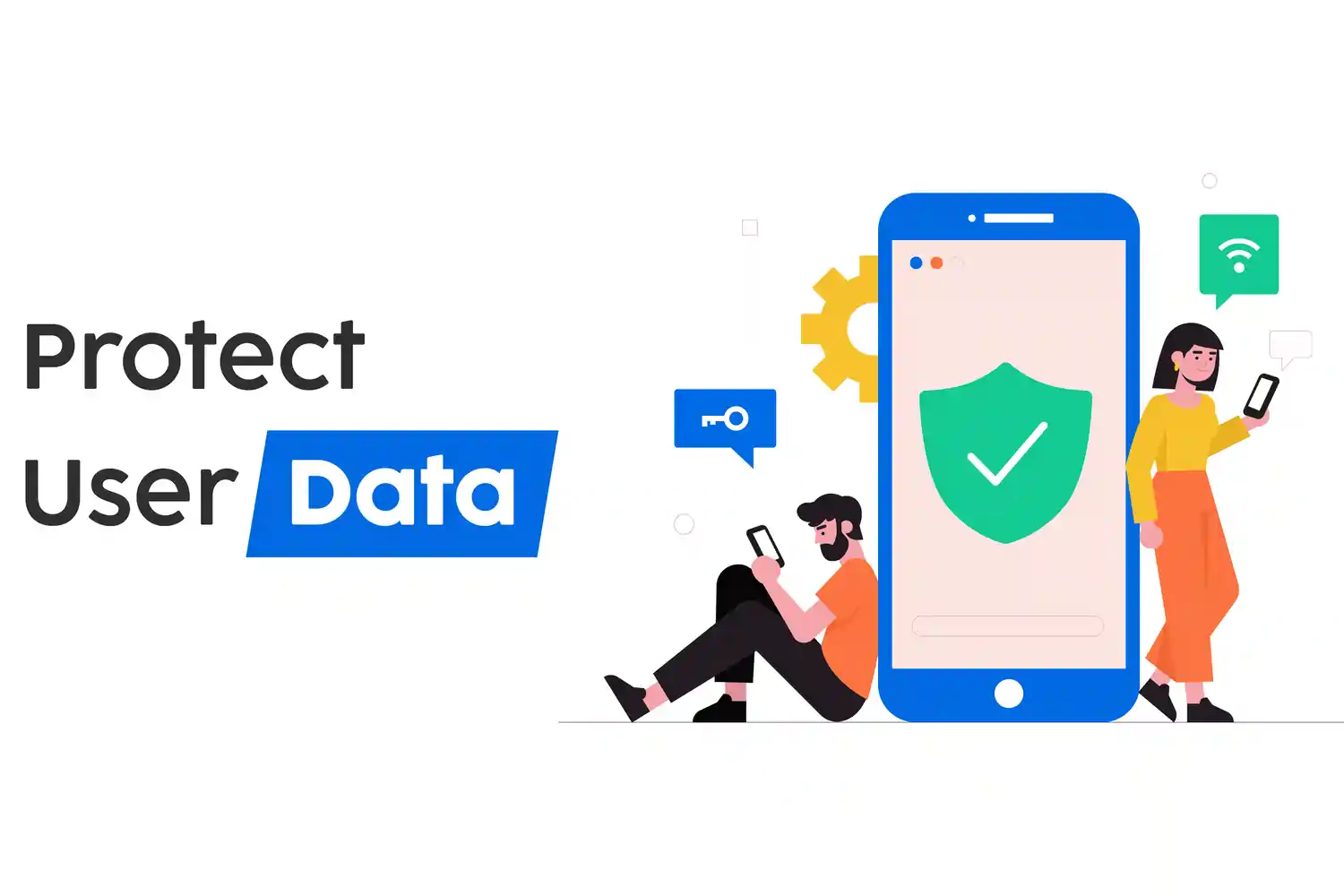
In the present world where app development services and web development services are dominated by online services, customer data protection is of utmost importance to firms. The threats are even getting more complex, or rather it is ever hard for organizations to guard their important information. That being the case, here are seven compliance measures to follow to safeguard your customers’ data while on your website and mobile applications.
Another measure that is both easy and very valuable for safeguarding your customers’ information is to adopt HTTPS on your site. Using HTTPS, a user entering personal or credit card numbers, passwords, or other sensitive data on your webpage will be protected against hackers trying to intercept this information.
Not only is changing to HTTPS helpful to your security, but it is also beneficial to your company’s SEO rankings. The fact is that Google and other popular search engines prefer sites for which the admin uses certificates for securing connections. Also, showing the padlock symbol in the address bar builds trust with your customers, and they relax knowing that you will safeguard their information.
Switching to HTTPS provides several benefits:
Data Encryption: All data transmitted between the user and the server is encrypted, ensuring privacy and security.
Improved SEO: Search engines, particularly Google, favor secure websites in their rankings. This can lead to increased visibility and traffic.
Customer Trust: The sight of the padlock symbol in the browser’s address bar reassures users that their data is safe, enhancing your brand’s credibility.
You should therefore guide your customers to set very good passwords. Passwords should be alphanumeric, with both different upper and lower cases, and also include symbols. Also, password updates are helpful to carry out due to their security issues; this can also be complemented by a policy of frequent updates of passwords.
Furthermore, it will also be advisable to add two-factor authentication (2FA) to your website and application. This enhances the security when logging in as the user is forced to do it in two steps by use of a token, an SMS or an authentication app. By doing so you will minimize the risks of unauthorized access to the users’ accounts.
Complex passwords: Users are advised to include a mix of uppercase and lowercase letters, numbers, and special characters in their passwords.
Regular updates: Encourage regular password changes and prompts to do so.
Benefits of two-factor authentication
Advanced security: even if the password is compromised, attackers still need a second factor to access the account.
User awareness: Users will be more aware of security practices when additional verification steps are required.
Implementing strong password policies and 2FA not only protects customer accounts but also instills confidence in your users regarding your commitment to their security.
Whether you're building a company website using a content management system or creating an application for mobile devices, You need to update your software and plugins. Software manufacturers also release new versions that often have new features. But it also fixes bugs in the plugin. Recently discovered security vulnerabilities.
Vulnerability management: Hackers often take advantage of outdated software. Regular updates help close these gaps and prevent potential attacks.
Improved functionality: Updates can also introduce new features and improve performance. Improved overall user experience
Set a schedule for regular maintenance of your website development and app development services. This includes not only the original software but also the original software. But it also includes third-party plug-ins and libraries. Additionally, review and remove unused or outdated plug-ins. This is because they can be used as a starting point for hackers.
To smooth this process, consider using tools that automate software updates and notify you of any necessary patches. This proactive approach helps keep your systems secure without requiring constant manual intervention.
In the discussion of security probabilities and threats, encryption is one of the most efficient protection techniques for important data. Encryption of data also helps in the sense that if a cybercriminal gets into your company’s database, he or she cannot access the information because it is encrypted, and I explained how it is encrypted.
Purchase encryption protocols for data and its transmission, storage as well as while it is in circulation. For instance, apply SSL/TLS certificates for data sharing and where storing rather explicit information in databases. This means that even if the system is compromised your customers’ details are safe from theft.
Data in Transit: Use protocols like SSL/TLS to encrypt data transmitted between the user's browser and your server.
Data at Rest: Implement encryption for sensitive data stored in your databases. This ensures that even if hackers gain access to your data storage, the information remains protected.
Symmetric Encryption: Uses the same key for both encryption and decryption. Suitable for rest of data
Asymmetric encryption: Use the appropriate key pair. (public and private) to maintain data security in transit
You can greatly increase the security of your customer data by implementing strong encryption measures. Makes it more difficult for attackers to attack.
Security check ups should be done frequently to help in the discovery of the weaknesses of your website or your mobile application. These audits should also incorporate reviews of your security measures, data handling protocols and the GDPR/CCPA guidelines.
Outsourcing security requires an objective view, which the internal team may lack; the third-party people can spot vulnerabilities your team won’t. Performing these audits on the regular will help you be proactive and make sure that your data protection plans are always advancing.
Identify weak points: Regular audits help identify gaps in your security infrastructure that need to be addressed.
Increased compliance: Compliance with data protection regulations reduces legal risks and potential penalties.
Improving incident response: Regular reviews prepare your team to respond quickly and efficiently to security incidents.
Consider hiring an outside security expert to perform these audits. Unbiased assessments can provide insights that your internal team may miss.
Various tools They can help carry out security checks, for example:
Vulnerability Scanner: Identify potential vulnerabilities in your system.
Penetration Testing Tool: Simulate an attack to assess your security posture.
By conducting regular inspections You can proactively patch vulnerabilities and continuously improve your data protection strategy.
Human error is often the weakest link in cybersecurity. Providing training and resources to your team can greatly reduce the risk of a data breach. Educate your employees about phishing scams. Social engineering strategies and best practices for managing sensitive data.
Additionally, consider providing your customers with resources on how to protect their data. This may include tips for creating strong passwords. Identifying phishing attempts and understanding their rights regarding data protection. An informed customer base is less likely to fall victim to an attack. Which will ultimately benefit your business.
Conduct regular training for your employees. It covers various topics such as
Phishing Awareness: Educate employees on how to detect phishing attempts. and avoid becoming a victim of scams.
Data Handling Best Practices: Provide guidelines for securely managing sensitive customer data. and respond to potential security incidents.
Consider providing resources to customers on how to protect their information. This may include:
Guides on Creating Strong Passwords: Provides clear guidance on creating strong passwords and avoiding common mistakes.
Recognizing Scams: Educate customers on how to identify fraudulent communications and avoid potential scams.
By promoting a culture of safety awareness both internally and externally. You can help reduce risk and create a safer environment for your customers.
This is despite all the necessary precautions being taken. Data breaches can still happen. A well-defined incident response plan is required to minimize damage and ensure a speedy recovery.
Introduction: Summary of how to identify a data breach.
Controls: Put in place processes to deal with breaches and prevent further loss of data.
Notification: Establish a protocol for timely notification of affected customers and regulatory agencies.
Assessment: Evaluate the extent of the damage and the nature of the violation.
Recovery: Take measures to recover the system and prevent future incidents.
Test and update your incident response plan regularly to ensure its effectiveness. Practice data breach simulations and evaluate your team's response. This proactive approach can help your team respond quickly and effectively to real crises.
As technology develops So are threats to customer data. Staying informed about the latest cybersecurity trends and best practices is essential for continued protection. Invest in continuous learning and improve your strategy to adapt to the ever-changing cybersecurity landscape.
By following these guidelines By giving importance to information security You can create a safe digital experience for your customers and maintain a solid reputation in a competitive market...
In an era where data breaches are a constant threat Protecting customer data is more important than ever. By using these seven strategies You can avail app and website development services. To significantly increase the security of your website and mobile applications
Prioritizing the protection of customer data not only helps you stay compliant but also protects your customers' data. But it also fosters trust and loyalty among your users. Remember that investing in safety measures today can prevent disastrous consequences in the future. Your customers deserve to feel safe when interacting with your digital platforms. And it is your responsibility to provide that guarantee.
In today’s fast-paced digital environment, protecting customer data is paramount for building trust and ensuring smooth interactions. At Digittrix, we specialize in implementing robust security measures that safeguard your customers' information across your web or mobile applications.
With 14 years of experience, Digittrix empowers your business to prioritize customer data security while enhancing user engagement. If you want to strengthen your application's security or are unsure how to start, schedule your appointment or book a consultation today with our expert technical managers by calling +91 8727000867,
or writing to us with your queries at digittrix@gmail.com


Written by Vandana Abrol
An enthusiastic developer and skilled business management expert with over a decade of experience in the field
Do you need help in Security and Privacy?




Join over 1500+ businesses we've already helped!
Data security is crucial to protect sensitive customer information, maintain customer trust, comply with legal regulations, and avoid financial losses associated with data breaches. Ensuring the safety of customer data enhances your brand's reputation and fosters user loyalty.
HTTPS (HyperText Transfer Protocol Secure) is a secure version of HTTP. It encrypts data exchanged between the user’s browser and your server, protecting sensitive information from being intercepted by malicious actors. Using HTTPS is essential for maintaining user trust and improving your website's SEO ranking.
Encourage your customers to create complex passwords by using a mix of uppercase and lowercase letters, numbers, and special characters. You can also implement password strength meters and provide guidelines to help them choose secure passwords.
Two-factor authentication (2FA) is a security process that requires users to provide two different authentication factors to verify their identity. It adds an extra layer of security beyond just passwords, making it much harder for unauthorized users to access accounts even if they have the password.

©2025Digittrix Infotech Private Limited , All rights reserved.